Long-term spatial memory and morphological changes in hippocampus of Wistar rats exposed to smoke from Carica papaya leaves
Aboyeji Lukuman Oyewole, Bamidele Victor Owoyele
Department of Physiology University of Ilorin, Ilorin, Nigeria
Long-term spatial memory and morphological changes in hippocampus of Wistar rats exposed to smoke from Carica papaya leaves
Aboyeji Lukuman Oyewole*, Bamidele Victor Owoyele
Department of Physiology University of Ilorin, Ilorin, Nigeria
PEER REVIEW
Peer reviewer
JEJE, Sikirullai Olatunde, Department of Physiology, Faculty of Basic Medical Sciences. Cross River University of Technology, (Okuku Campus) Cross River.
Tel: +23480 8632 7115
E-mail: dhikrilat@yahoo.com
Comments
This is a good study, in which the author evaluated the effects of smoke of papaya on the long term spatial memory. The results are interesting and suggested that at low dose, smoke of papaya might be beneficial to people who smoke it.
Details on Page 217
Objective:To investigate the effects of smoking of dried leaves of Carica papaya (pawpaw) based on ethnopharmacological information which indicated that smoking of papaya leaves could influence motor performance and learning.
Maze, Spatial memory, Smoking, Carica papaya, Rats, Hippocampus
1. Introduction
Carica papaya(pawpaw) is an evergreen shrub or small tree that grows better in full sun than in light shade. This tropical plant is a member of the family Caricaceae. They often grow to a height of 3-6 meters. The trunk is usually unbranched and crowed with large spirally arranged leaves that give the tree a palm-like appearance[1-3]. This family consists of 55 species[4]. Pawpaw leaf was documented to be used for treatment of toothache, tuberculosis, liver ailments, constipation, arthritis and rheumatism[5,6].
A survey by Olley showed that pawpaw leaf is smoked with a believe that it has the ability to act on the central nervous system like cannabis[7]. Likewise in our earlier study[8], we reported that exposure to the smoke from papaya has anxiolytic effects using hole board and open field mazes.
The present study is therefore a further study into the effects of pawpaw smoking on long term spatial memory and ultimately on the morphology of the hippocampus. Memory can be influenced by several factors, such as drugs and phytochemical agents[9-14]. Such agents include caffeine, cannabis, alcohol, tobacco and many others. The temporal lobes of the cortex, mammilary bodies and hippocampus are associated with the processing of long time memory[15-18]. Diseases affecting these structures tend to lead to defective long term memory[19-21]. It is expected that results obtained from the Morris water maze and morphological analysis will provide information on the effect of smoking of papaya leaves on central nervous system function. Since some anxiolytic substances equally has effects on long term memory. The present study is therefore a further study into the effects of pawpaw leaf smoking on long termspatial memory and ultimately on the morphology of the hippocampus.
2. Materials and methods
2.1. Plant preparation
Dry papaya leaves were collected at the outskirt of the University of Ilorin, Kwara State, Nigeria in April of 2010. The plant was earlier identified by T. K. Odewo and given a herbarium number FHI 106933 at the Forestry Research Institute of Nigeria when it was harvested for a previous study[5]. Forty pawpaw leaves were harvested and used for this study. The spines of the dry leaves were immediately removed so that only the blades of the leaves remained. Thereafter, the blades were reduced to small bits and subsequently packaged into various dosages. These dosages which corresponded with average weight of half leaf, whole leaf and one and half leaves are 26.94 g/kg (low dose), 53.88 g/ kg (medium dose) and 80.82 g/kg (high dose) respectively as previously explained[8].
2.2. Animals
Twenty-four adult male Wistar rats of an average weight of (232±6) g were used for this investigation. They were housed and bred in the animal house of the Faculty of Basic Medical Sciences, College of Health Sciences, University of Ilorin, Nigeria. The animals were kept in standard cages with good ventilation and environmental conditions. Prior and during the research period, animals were allowed free access to feeds (mouse pellet) and clean water. Ethical guidelines of the College of Health Sciences, University of Ilorin on animal’s experiment were strictly followed. These guidelines are in accord with the internationally accepted principles for laboratory animal use and care[22].
The rats were randomly grouped into four groups with six rats forming a group and were allowed to acclimatize for 7 d. On the last day of acclimatization, each rat was trained to locate escape platform in the Morris water maze in accordance with Gouirand and Matuszewich in 2005[23]. After satisfactory learning, each group was labeled as follows: control group, low dose group, medium dose group and high dose group. Animals in the control group were subjected to all other conditions just as the other groups except exposing the animals to smoke from pawpaw leaf. The low dose group was exposed to smoke from dry pawpaw leaf of 26.94 g/kg (equivalent to 6.25 g). The medium dose group was exposed to smoke from dry pawpaw leaf of 53.88g/kg (equivalent to 12.50g) while the high dose group was exposed to smoke from dry pawpaw leaf of 80.82g/kg (equivalent to 18.75g). Each rat in the tested groups (i.e.low dose, medium dose and high dose group) was exposed individually to smoke from dry papaya leaf in a smoking chamber. The smoking chamber was previously described[8], briefly the chamber had three column which were perforated so that smoke can get from one chamber to the other. The first chamber has an attached electric burner that burns the leaves used and the chamber itself acted as heat absorber, absorbing heat generated from the burner. The second chamber acted as the heat breaker, limiting the heat that gets to third chamber and the third chamber accommodates the rat used. At the top of the third chamber, there is an outlet of 5 cm in diameter through which the smoke escape into the air. Exposure duration was 3 min twice per day (n=6), and the procedure (exposure to papaya smoke) was repeated for 21 d[8].
2.3. Memory test
In the Morris water maze test, the maze used was a prototype of the original Morris’ water maze. The original Morris water maze test was 214 cm in diameter. It can be described as a round tank (pool) of water with a depth of 0.6 m containing 0.3 m pool of water. The escape platform was 10 cm in diameter and it was painted white. The platform was 1/4 inches below the water and was not too close to the side of the tank, to prevent the rat from finding it by just circling around the poolside[24,25].
The pool and platform were coloured white using skim milk powder (for stopping the rat from seeing through the water). The platform was maintained in the same position throughout the period of the research. The long-term spatial memory of the animals was evaluated by placing each animal in the pool at any side of the tank but not near to the platform. The time taken for each animal to find and stand on the escape platform was documented using a stop clock. At the end of memory test in a Morris water maze, one animal in each group was sacrificed by cervical dislocation and the brain was removed and fixed in 10% formol calcium. Hippocampus was harvested from each brain for histological study using Hematoxylin & Eosin stain and Cresyl fast violet stain. These stains have a rich documentations of been used to investigate cellular morphology and the appearance of Nissl substance in the cells respectively[26,27]. The histological studies were done in the Laboratory of Department of Chemical Pathology, University of Ilorin, Nigeria.
2.4. Statistical analysis
In this study, values were expressed as mean±standard error of mean (SEM) and analysis was carried out by using One-way analysis of variance (ANOVA) at a statistical significant level ofP<0.05.
3. Results
3.1. Effect of smoke from pawpaw leaf on long-term spatial memory in the Morris water maze
The result of the Morris water maze test (Table 1) shows that spatial and long term memory recall duration significantly(P<0.05) reduced in the low and medium dose groups and significantly (P<0.05) increased in the high dose group.

Table 1 Effect of pawpaw leaf smoke on long-term spatial memory in rats using Morris water maze test.
3.2. Effect of smoke from pawpaw leaf on hippocampal cells and Nissl substance
Using hematoxylin and Eosin stain, histological investigation of hippocampus shows normal cells distribution and arrangement in the control (Figure 1), low dose and medium dose groups (Figure 2 and 3). Some cells in the low and medium dose groups were characterized with large perinuclear space. In the high dose group (Figure 4), there were obvious disrupted magnocellular layer and vasculations in the neural cells of the hippocampus.
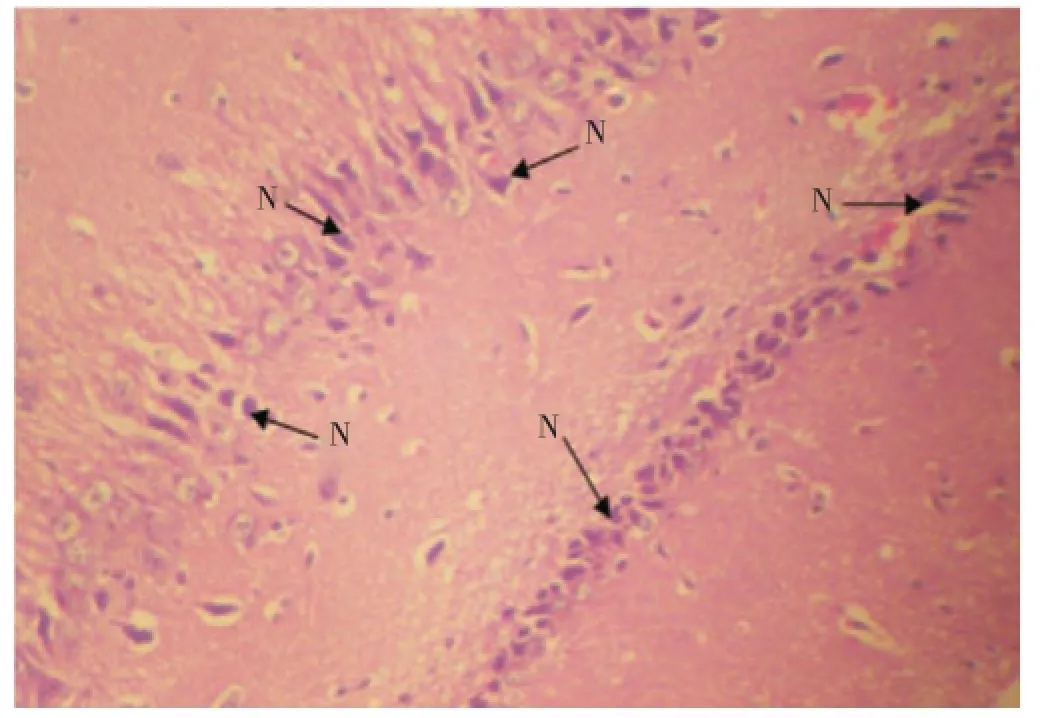
Figrue 1. Control group-Hippocampus (×160), using H&E stain. Control group cells are normal in term of cells morphology, arrangement and distribution. In addition, cells are normochromic in appearance. N-Neural cell.

Figure 2. Low dose group-Hippocampus (×160), using H&E stain. Cells in hippocampus tissue of low dose group are also normal in term cells morphology, arrangement and distribution. However, appearance is hypochromic.N: Neural Cell, PN: Perinuclear space.
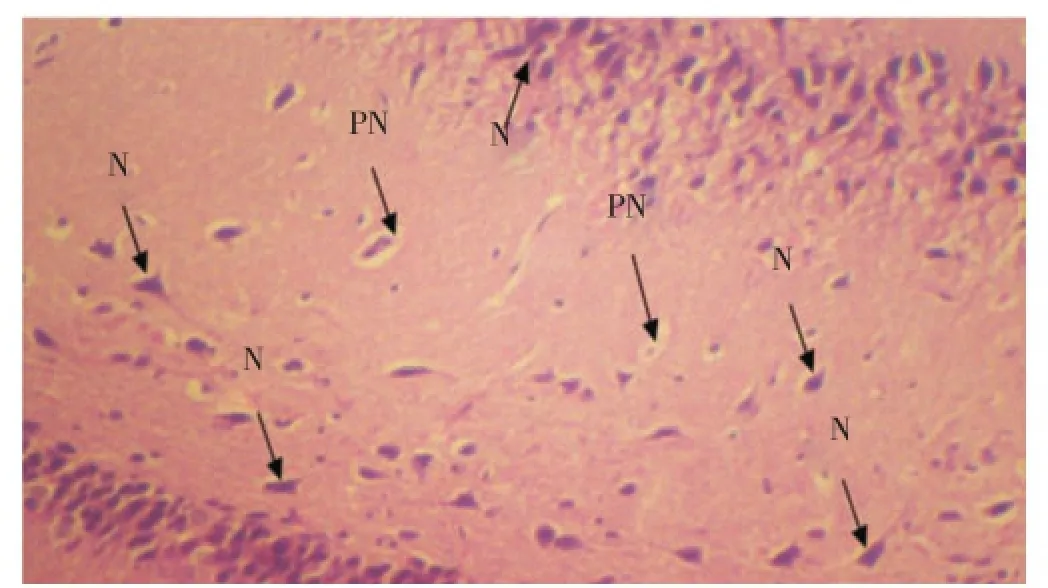
Figure 3. Medium dose group-Hippocampus (×160), using H&E stain. In the Medium dose group, cells in the hippocampus tissue have normal cells morphology, arrangement and distribution. Cells also appeared hypochromic. PN: Perinuclear space N: Neural cell.
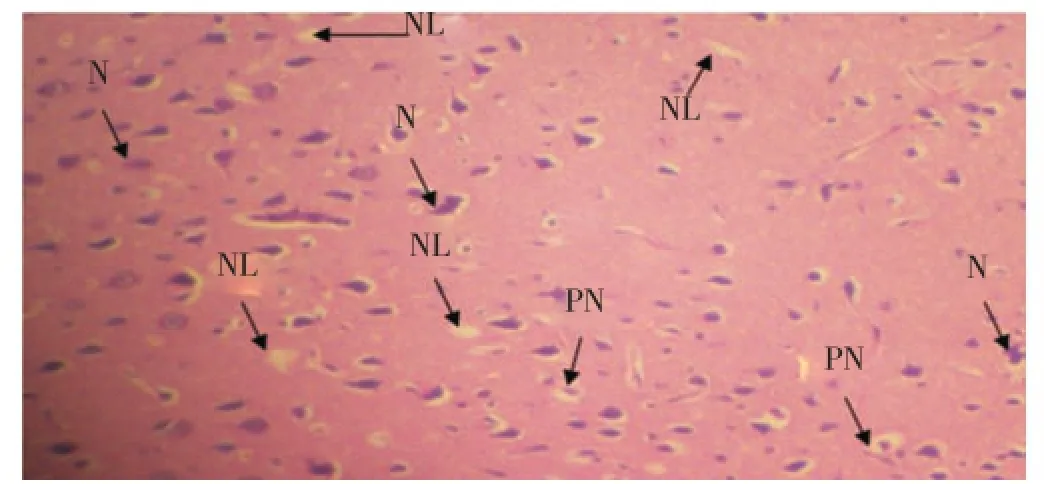
Figure 4. High dose group-Hippocampus (×160), using H&E stain. In the High dose group, hippocampus cells were characterized with disrupted magnocellular layer and vasculations suggesting mild neural degeneration.N: Neural cell, NL: Neural lesion, PN: Pernuclear space.
Using cresyl fast violet stain, the Nissl substance in the smoke exposed groups showed changes in staining properties (hypochromia) compared to the control group (Figure 5). This hypochromic appearance is more obvious in the high dose group (Figure 6) than the low dose and medium dose groups (Figure 7 and 8 ).
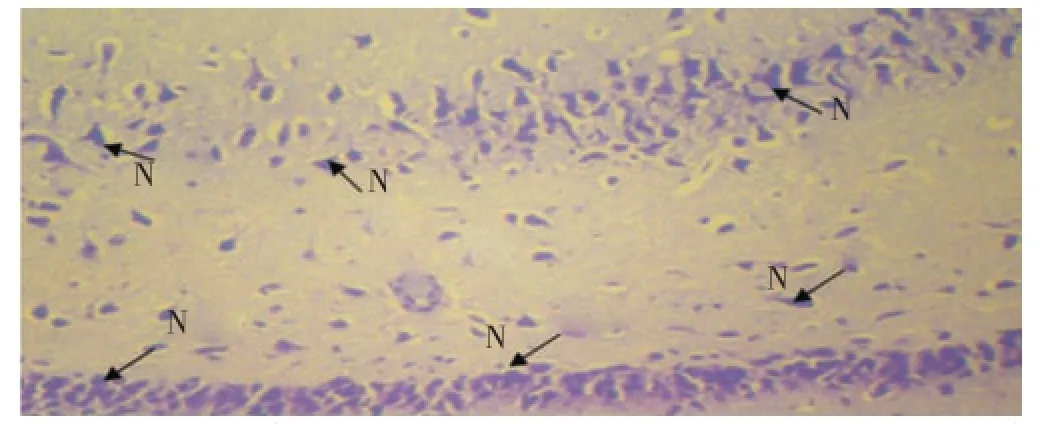
Figure 5. Control group-Hippocampus (×160), using CFV stain. Nissl substances were normally stained and were well distributed.N-Neural cell.
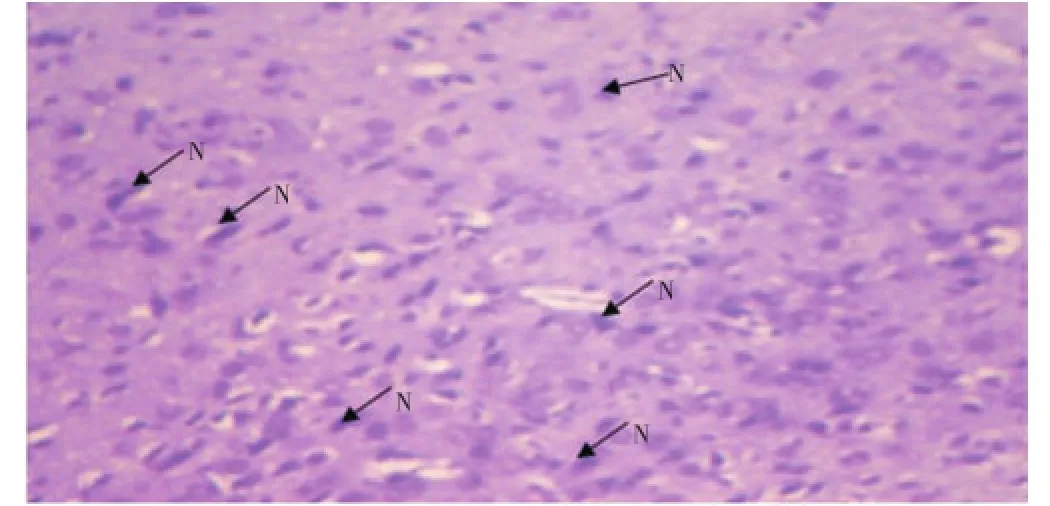
Figure 6. High dose group-Hippocampus (×160), using CFV stain. There was complete layer disorganization of hippocampus tissue and obvious decrease in nissl substances.N-Neural cell.
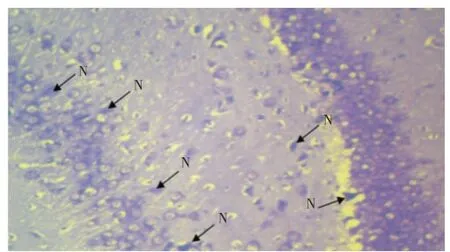
Figure 7. Low dose group-Hippocampus (×160), using CFV stain. Nissl substance was normally stained and was well distributed though it is hypochromic in appearance.N-Neural Cell.
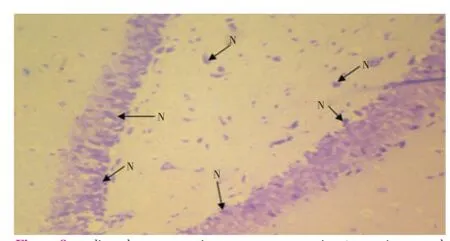
Figrue 8. Medium dose group-Hippocampus (×160), using CFV stain. Normal tissue was observed but with reduced nissl substances and disrupted distribution. N-Neural Cell.
4. Discussion
The Morris water maze was first described about 29 years ago, it is a device that has stood the test of time for investigating spatial learning and memory in laboratory rats[25]. In recent time, it has become one of the most frequently used laboratory tools especially in behavioral neuroscience[28].
In this study, reintroducing the animals back to the MWM after days of exposure to smoke emanating from papaya leaves showed that the animal’s long-term spatial memory was intact in the treated groups. In fact, long-term spatial memory in both the low and medium dose groups appeared to be improved. This was deduced from the observed retrieval duration of long-term spatial memory that was significantly decreased when compared with the control group. For the high dose group, however, the retrieval duration of the longterm spatial memory was significantly increased compared with the control group. In other words, animals in the high dose group exhibited delay in getting to the hidden platform compared to the control group. Nevertheless, the fact that the animals were able to locate and mount the escape-platform proved that the memory of the animals were intact. The only explanation for this is that the smoke from papaya leaves probably reduced the anxiety of the animals in the water and therefore decreased the desire to escape even though the animals knew where the escape platform was located. This is in accordance with the result of our previous study on the leaves of the plant[8]. Alternatively, there may be lesion in fimbria-formix due to the effect of the smoke, this in turn may render the hippocampus dysfunction[29]. Eichenbaumet al. demonstrated that fimbria-formix lesioned rats were indeed slower in acquiring the hidden platform task than the control rats[30]. In the present study, histological investigation on fimbria-formix was not carried out to ascertain this. Lesion of the hippocampus can also account for this delay, Pearceet al. reported that hippocampus-lesioned rats could still locate a hidden-platform if it was always at the same distance and direction from a visible landmark and this demonstrated that the ability to use heading vector was preserved[31]. The first reason for anxiolytic effects of smoking papaya leaves appears to be true for these animals, this is supported by observations which shows that animals exposed to smoke from high dose of leaves were less anxious than other groups as previously reported[8].
Histologically, smoking of papaya leaves led to a change (hypochromia) in the staining properties of the cells and Nissl granules in the groups exposed to smoke from minimal and moderate doses of papaya leaves despite the fact that cells structure and arrangement are the same with the control group. This is an indication that the cells are less active and may produce lesser amount of neurotransmitters in these groups. Furthermore, perinuclear space of the nucleus in some of the neural cells were seen to be larger than the control group. This is believed to be swelling and it has been linked with an onset of necrosis[32-34]. Thus, there is a probability that actual neural degeneration might occur if animals’ exposure to the smoke continued longer than the 21 d used in this study. In the group exposed to smoke from high dose of pawpaw leaves, the hippocampal cells were marked with obvious reduction in Nissl substances, disrupted magnocellular layer and vasculations which is suggestive of mild neural degeneration. However, despite the observed histological changes, all animals exposed to smoke from pawpaw leaves were able to navigate their way to the escapeplatform even with better performance by those exposed to smoke from minimal and medium doses of the leaves. As shown in the result, Group 2 and 3 escaped faster than the Group 1 while Group 4 was slower than Group 1.
The results from Morris water maze and the histological observations in this study is not in agreement with the findings of Clarket al. Clarket al. argued that even if rats were trained daily for 90 d and hippocampus lesion was induced on the 100th d after completing the training, remote spatial memory in water maze would be impaired[35]. It is surprising that hippocampus lesion can cause remote spatial memory impairment in rats especially when considering the fact that man with extensive hippocampal lesion can still mentally navigate his way around his childhood environment[36]. It’s still surprising that rats that failed the water maze test were able to perform wonderfully in the other remote spatial memory tests[37,38]. Our study is in agreement with the findings of Squireet al[24]. In their studies, recent memory was tested a day after the training and the remotememory was tested 30 d after the training, they observed that the recent memory was impaired while the remote memory was intact after hippocampal lesion. This explains why all the animals exposed to pawpaw smoke were able to navigate to the escape-platform despite the observed histological changes in their hippocampal cells. Thus our study joins the queue of other studies which concluded hippocampus is not necessary for mental navigation of remotely learned environments[36], and it will be correct to say after learning, memory becomes gradually separated or independent of hippocampus with time.
The previously[5] identified active agents in papaya include the following saponins, cardiac glycosides, anthraquinones and reducing sugars, flavonoids, tannins, alkaloids (including carpain and pseudocarpain) flavonols, glycosides and phenolics[39-41]. Other constituents reported by Gill include nicotinic acid and tocopherol[39]. One (especially nicotinic acid) or a combination of these active ingredients might be responsible for the effect of the smoke on the animals. Further studies are required to investigate fully and isolate each biochemical agent or metabolite.
In conclusion, this investigation shows that smoke from dry pawpaw leaves has no detrimental effect on long time and spatial memory. At low dosage, it might be useful in enhancing memory but at high dose this effect is obliterated in a seemingly non detrimental manner. This may be the reason why the pawpaw leaves smokers are fond of it, so further research is encouraged in order to unravel the toxicological effects of smoking dry pawpaw leaves.
Conflict of interest statement
We declare that we have no conflict of interest.
Acknowledgements
We thank the Senate of University of Ilorin for her support and Mrs Bello E Funlola for providing us the analytical balance. This work was partly supported by Senate Research Grant of the University of Ilorin, SRG 2010.
Comments
Background
The effects of smoking of agents such as tobacco and cannabis on memory have been reported in literature. Several structure in the brain are said to be associated with the processing of long time memory and this include hippocampus. The literature review reveals that papaya leaves has anxiolytic substance. Anxiolyotic substance may affect long term memory. Nicotinic acid is one part of the constituents of papaya and this is the major constituent in tobacco that has been reported to affect memory.
Research frontiers
Studies are being performed in order to determine the effects of smoking papaya leaves on long time and spatial memory in rats.
Related reports
The results from Moris water maze and histological observation in this study is not in agreement with the findings of Clarket al.(2005). Clarket al.argued that even if rats were trained daily for 90 d, hippocampus lesion induced in the 100th day, will impaired remote spatial memory in water maze. Even these rats were able to perform wonderfully in the remote spatial memory tests. This is however in agreement with the findings of Squireet al.(2004).
Innovations and breakthroughs
Data from this studies shows that smoke from dry pawpaw leaves has no detrimental effect on long time and spatial memory. At low dosage, it might be useful in enhancing memory.
Applications
The effect of smoke from dry pawpaw on long term spatial memory is important because people are fond of it without proper understanding of its toxicological value. And like other agents such as cannabis, tobacco, it may affect neurobehaviour.
Peer review
This is a good study, in which the author evaluated the effects of smoke of papaya on the long time and spatial memory. The results are interesting and suggested that at low dose, smoke of papaya might be beneficial to people who smoke it.
[1] Purseglove JW. Tropical crops: dicotyledons. London: Longman Group Limited; 1968.
[2] Aliyu BS. Some ethnomedicinal plants of the Savannah region of West Africa: description and phytochemicals. Nigeria: Triumph Publishing Company Ltd; 2006, p. 243-244.
[3] Hernández-Hernández CN, Valle-Mora J, Santiestban-Hernández A, Bello-Mendoza R. Comparative ecological risks of pesticides used in plantation production of papaya: application of the SYNOPS indicator. Sci Total Environ 2007; 381(1-3): 112-125.
[4] Dallwitz MJ. A general system for coding taxonomic descriptions. Taxon 1980; 29(1): 41-46.
[5] Owoyele BV, Adebukola OM, Funmilayo AA, Soladoye AO. Antiinflammatory activities of ethanolic extract of Carica papaya leaves. Inflammopharmacology 2008; 16(4): 168-173.
[6] Anibijuwon II, Udeze AO. Antimicrobial activity of Carica papaya (pawpaw leaf) on some pathogenic organisms of clinical origin from south western Nigeria. Ethnobotanical Leaflets 2009; 13: 850-864.
[7] Olley BO. Is dried pawpaw leaf a psychoactive substance? IFEPsychologIA 2007; 15(1): 25-39.
[8] Oyewole AL, Owoyele BV. Neurobehavioural effects of exposure of Wistar rats to smoke from traditional Carica papaya (pawpaw) leaves. Int J Genuine Tradit Med 2012; 2(4): doi: 10.5667/ tang.2012.0035.
[9] Bostock E, Gallagher M, King RA. Effects of opiod microinjections into the medial septal area on spatial memory in rats. Behavi Neurosci 1988; 102(5): 643-652.
[10] Elizabeth AP. Human emotion and memory: interactions of the amygdale and hippocampal complex. Curr Opin Neurobiol 2004; 14(2): 198-202.
[11] van Praag H, Lucero MJ, Yeo GW, Stecker K, Heivand N, Zhao CM, et al. Plant-derived flavanol (-)epicatechin enhances angiogenesis and retention of spatial memory in mice. J Neurosci 2007; 27: 5869-5878.
[12] Ramirez MR, Izquierdo I, do Carmo Bassols Raseira M, Zuanazzi JA, Barros D, Henriques AT. Effect of lyophilised Vaccinium berries on memory, anxiety and locomotion in adult rats. Pharmacol Res 2005; 52: 457-462.
[13] Ruscheweyh R, Willemer C, Krüger K, Duning T, Warnecke T, Sommer J, et al. Physical activity and memory functions: an interventional study. Neurobiol Aging 2011; 32(7): 1304-1319.
[14] Ballard ME, Gallo DA, de Wit H. Psychoactive drugs and false memory: comparison of dextroamphetamine and δ-9-tetrahydrocannabinol on false recognition. Psychopharmacology 2012; 219(1): 15-24.
[15] Scoville WB, Milner B. Loss of recent memory after bilateral hippocampal lesions. J Neurol Neurosurg Psychiatry 1957; 20: 11-21.
[16] Rosenstock J, Field TD, Greene E. The role of mammillary bodies in spatial memory. Exp Neurol 1977; 55(2): 340-352.
[17] Jarrard LE. On the role of the hippocampus in learning and memory in the rat. Behav Neural Biol 1993; 60(1): 9-26.
[18] Squire LR, Stark CE, Clark RE. The medial temporal lobe. Annu Rev Neurosci 2004; 27: 279-306.
[19] Kolb B, Wishaw IQ. Fundamentals of Human Neuropsychology. New York: WH Freeman and Company; 1996.
[20] Mesulam MM. Principles of behavioral and cognitive neurology. 2nd ed. USA: Oxford University Press; 2000.
[21] Newman MF, Kirschner JL, Phillips-Bute B, Gaver V, Grocott H, Jones RH, et al. Longitudinal assessment of neurocognitive function after coronary-artery bypass surgery. N Engl J Med 2001; 344(6): 395-402.
[22] Gouirand AM, Matuszewich L. The effects of chronic unpredictable stress on male rats in the water maze. Physiol Behav 2005; 86: 21-31.
[23] National Research Council of National Academics. Guide for the care and use of laboratoryanimals. 8th ed. Washington DC: National Academic Press; 2010.
[24] Squire LR, Clark RE, Bayley PJ. Medial temporal lobe function and memory. In: Gazzaniga MS, editor. The cognitive neurosciences. Cambridge: the MIT Press; 2004.
[25] Morris R. Developments of a water-maze procedure for studying spatial learning in the rat. J Neurosci Methods 1984; 11(1): 47-60.
[26] Baron JA. Cigarette smoking and Parkinson’s disease. Neurology 1986; 36(11): 1490-1496.
[27] Adeniyi PA, Ghazal OK, Musa AA, Caxton-Martins EA. The neurobehavioural effects of smoke and ethanolic extract of Nicotiana tabacum leaves exposure in mice. Res J Anim Sci 2010;4(4): 99-102.
[28] D’Hooge R, De Deyn PP. Applications of the morris water maze in the study of learning and memory. Brain Res Brain Res Rev 2001; 36(1): 60-90.
[29] Whishaw IQ, Jarrard LE. Similarities vs. differences in place learning and circadian activity in rats after fimbria-fornix sectionor ibotenate removal of hippocampal cells. Hippocampus 1995; 5(6): 595-604.
[30] Eichenbaum H, Stewart C, Morris RG. Hippocampal representation in place learning. J Neurosci 1990; 10(11): 3531-3542.
[31] Pearce JM, Robert AD, Good M. Hippocampal lesions disrupt navigation based on cognitive maps but not heading vectors. Nature 1998; 396(6706): 75-77.
[32] Kerr JF, Wyllie AH, Currie AR. Apoptosis: a basic biological phenomenon with wide-ranging implications in tissue kinetics. Br J Cancer 1972; 26(4): 239-257.
[33] Majno G, Joris I. Apoptosis, oncosis, and necrosis. An overview of cell death. Am J Pathol 1995; 146(1): 3-15.
[34] Trump BF, Berezesky IK, Chang SH, Phelps PC. The pathways of cell death: oncosis, apoptosis, and necrosis. Toxicol Pathol 1997; 25(1): 82-88.
[35] Clark RE, Broadbent NJ, Squire LR. Impaired remote spatial memory after hippocampal lesions despite extensive training beginning early in life. Hippocampus 2005; 15(3): 340-346.
[36] Moscovitch M, Nadel L, Winocur G, Gilboa A, Rosenbaum RS. The cognitive neuroscience of remote episodic, semantic and spatial memory. Curr Opin Neurobiol 2006; 16(2): 179-190.
[37] Cho YH, Kesner RP, Brodale S. Retrograde and anterograde amnesia for spatial discrimination in rats: role of hippocampus, entorhinal cortex and parietal cortex. Psychobiol 1995; 23: 185-194.
[38] Ramos JM. Retrograde amnesia for spatial information: dissociation between intra and extramaze cues following hippocampus lesions in rats. Eur J Neurosci 1998; 10(10): 3295-3301.
[39] Gill LS. Ethnomedical uses of plants in Nigeria. Benin, Nigeria: University of Benin press; 1992.
[40] Rawlings ND, Barrett AJ. Families of cysteine peptidase. Methods Enzymol 1994; 244: 461-486.
[41] Ayoola GA, Coker HA, Adesegun SA, Adepoju-Bello AA, Obaweya K, Ezennia EC, et al. Photochemical screening and antioxidant activities of some selected medicinal plants used for malaria therapy in South Western Nigeria. Trop J Pharm Res 2008; 7(3): 1019-1024.
10.1016/S2221-1691(14)60234-3
*Corresponding author: A. L. Oyewole, Department of Physiology, University of Ilorin, P. M. B. 1515, Ilorin, Nigeria.
Tel: +23480 6919 8524
E-mail: oyewole6@gmail.com
Foundation Project: Partly supported by Senate Research Grant of the University of Ilorin (SRG/FBMS/01/2010).
Article history:
Received 27 Dec 2013
Received in revised form 5 Jan, 2nd revised form 13 J an, 3rd revised form 21 Jan 2014
Accepted 22 Feb 2014
Available online 28 Mar 2014
Methods:Twenty-four rats were used for the study, and were grouped into four groups. Groups 1 served as the control (not exposed to papaya leaves smoke), while Groups 2, 3 and 4 were exposed to smoke from 6.25 g, 12.50 g and 18.75 g of dry pawpaw leaves respectively in a smoking chamber twice daily for 21 d with each exposure lasting for 3 min. Lastly, hippocampus was harvested in each group for histological study.
Results:The results showed that there were significant (P<0.05) increases in mean of recall latencies of long-term spatial memory in the animal administered the high dose while the other groups had significantly (P<0.05) lower frequencies. Histological investigation showed signs of mild neural degeneration in high dose group and hypochromic appearance of the Nissl substance in all treated groups.
Conclusions:In conclusion, the findings from this study has demonstrated that smoking of papaya leaves has the ability to maintain an intact long-term spatial memory at all doses but retrieving such memory is faster with the low and medium dosages.
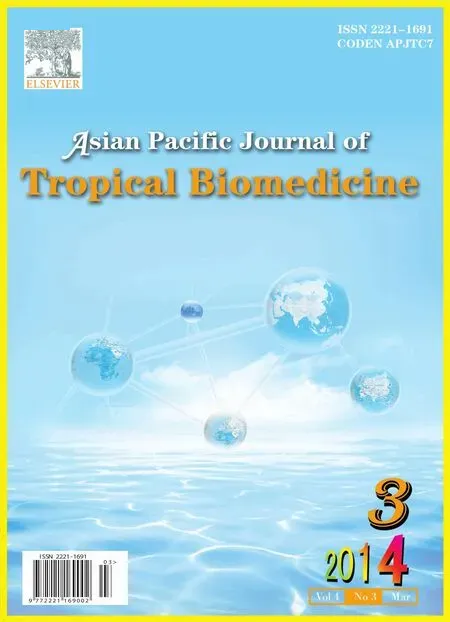 Asian Pacific Journal of Tropical Biomedicine2014年3期
Asian Pacific Journal of Tropical Biomedicine2014年3期
- Asian Pacific Journal of Tropical Biomedicine的其它文章
- An update on Ayurvedic herb Convolvulus pluricaulis Choisy
- Evidence of increasing L1014F kdr mutation frequency in Anopheles gambiae s.l. pyrethroid resistant following a nationwide distribution of LLINs by the Beninese National Malaria Control Programme
- Prevalence and antimicrobial resistance of Salmonella spp. in raw retail frozen imported freshwater fish to Eastern Province of Saudi Arabia
- Hesperidin as a preventive resistance agent in MCF-7 breast cancer cells line resistance to doxorubicin
- Anti-oxidative and anti-inflammatory effects of Tagetes minuta essential oil in activated macrophages
- Survey on cattle ticks in Nur, north of Iran
